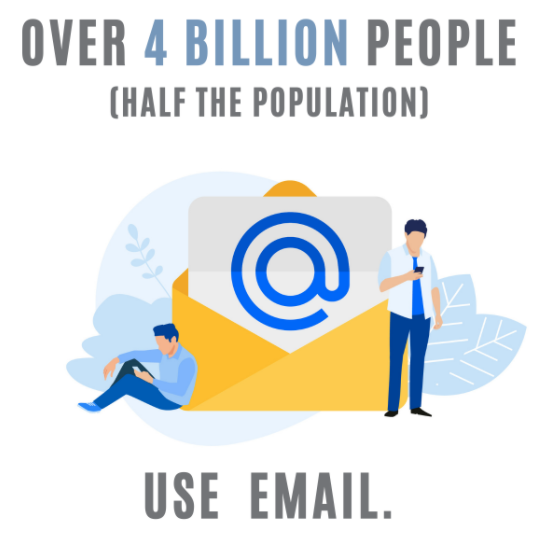Email Marketing that Delivers in 2021
Essential knowledge to making more money and wasting less effort in email this year
Here we are on the glorious frontier of 2021, with a world of possibility before us. If you hold still, you can hear the delightful hum of the internet, alive and thriving after reaching many milestones, as it helped us through the trials of 2020.
But before we dive into this year, let’s take a trip back to 1978, to a time before the web was worldwide.

Email Marketing’s Origin Story
In 1978, Gary Thuerk, a marketing manager at Digital Equipment Corporation, hit send on the very first email marketing blast, distributed via 400 Arpanet advertising machines.
And it did $13 million in sales!¹ That’s $51.9 million in today’s dollars!
Today in the email marketing game, everyone is your competition—spammers, moms emailing their kids, automatic updates, and of course, your actual industry competitors. Every time you land in an inbox, you’re competing for your prospect’s attention.To be fair, Thuerk had virtually no competition. Since 1978, the world has changed enormously.
Over 4 billion people—half the world’s population—now use email.² This is both a challenge and an opportunity. If done correctly, email can earn you upwards of $44 for every $1 spent.³ But in order to cut through the noise and get those results, you have to be relevant and engaging, while offering something valuable to your readers/customers.
Plus, you need to understand the importance of deliverability and the power of automation in your email campaigns. They are make-or-break.
Two Crucial Aspects of Email Marketing in 2021
Deliverability and Automation work together. They are the two legs that allow your campaign to truly run.
Deliverability
Deliverability is your percentage of emails that land in inboxes vs. spam folders.
In a technical sense, this is your highest goal. You want your email campaign to reach as many inboxes as possible. Email services like Gmail and Yahoo have spam filters, armed with algorithms that decide which emails are worthy of being ‘inboxed’ and which will be banished to spam folders.
There are surface-level rules, like penalties for too much bold text, all-caps, and exclamation points. (If you’re abusing these in your emails, STOP IT NOW!!!) Similarly, visual layout counts, so a professional design can improve not only the impression you make on readers, but also your deliverability.
Then there are technical, behind-the-scenes factors. For example—if you’re familiar with Search Engine Optimization—your email handle will receive a reputation score just as, in SEO, search engines rank the relevance or authority of your website. Over time, using common sense best practices and some technical know-how, you can grow your email reputation score and boost your deliverability.
Of course, your real highest goal, in a business sense, is to get Conversions. Sales. Dollars. Deliverability is the top of the funnel in email marketing. All other KPIs trickle down from there, namely: open rates, click-through rates, engagement, and (that’s right!) conversions.
Automation
Automation is how you program your email campaign to run most effectively.
Using an email management service, you can program all your pieces of email content to deploy exactly when you want, to the exact recipients you want. This means you don’t just make one email and blast it out to thousands of unsuspecting readers. (Gary Thuerk did it in 1978, but remember, he had no competition. Today it will get you blacklisted, doomed for spam folders.)
Automation takes some nuance and patience. To understand this, we have to back up and talk about segmentation.
You have a master list of email recipients. You can segment that list in a number of ways, including manual list-making and sorting by past engagement with your emails. Then you can use your different lists to strategically deploy emails. For example, suppose you send a weekly newsletter to a broad audience. After gathering data from those emails, you can target your most engaged audience with a special sales offer.
With the proper ongoing automation, and relevant content for the various parts of your audience, a little patience and a can-do attitude, you will boost your deliverability and the effectiveness of your email campaigns.
The Bigger Picture
Email on its own can be a powerful tool, but just as you can (and should) target various audiences, you can open the field even further when you use other tools like social media, podcasting, and SEO. You can use the profits from one effort to invest in the others, as you continually grow your business through digital marketing.
Then you can cross-pollinate your various platforms. You can use your email list to promote your podcast, your social media, and your website. And vice versa. Then you’ll find yourself with a marketing ecosystem, a strong framework for building a community and driving leads to your brand. The members of your community will bring you business for as long as you continue to engage them.
One More Thing
With all this talk of systems and automation, it’s important to remember—
Never take the marketer out of the marketing!
This is one of our central mantras here at Single Throw. In our digital world, it is entirely feasible to run a “set and forget” marketing campaign (we see it all the time).
But your prospects are real people, and even though there are screens, wires, and waves between us, we can never forget the human factor.
While digital tools give us unprecedented ability to monitor and automate campaigns, marketing efforts will largely fail without a human understanding to guide them—preferably an experienced human understanding.
If you’d like to learn more about email marketing, or chat about how you can use it to amplify your voice and grow your business, we’re happy to talk. Single Throw was born digital two decades ago, when the world was still spelling “e-mail” with a hyphen.








